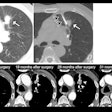One of the technical refinements in uterine artery embolization (UAE) has been the shift away from the use of irregularly shaped polyvinyl alcohol (PVA) particles and toward a spherical PVA agent. The third arm of a large-scale UAE study took a look at how these newer agents faired in UAE, as well as how the procedure compared to myomectomy.
PVA microspheres were developed in response to the disadvantages of irregular PVA agents, which include clumping, a potential for embolic occlusion, and size variability, explained Dr. Gary Siskin from Albany Medical College in Albany, NY. Siskin led a prospective multicenter trial that looked at UAE versus myomectomy. Their initial results were published in early 2006 (Fertility and Sterility, January 2006, Vol. 85:1, pp. 14-21).
"Patients present for UAE not simply because they have uterine tumors but because they have symptoms relating to these tumors, and it is critical to evaluate any procedure and any embolic agent...on its ability to address these issues," wrote Siskin and colleagues in their latest paper (Journal of Vascular and Interventional Radiology, August 2006, Vol. 17:8, pp. 1287-1295).
For the current study, a total of 146 patients were included. Of these, 77 underwent UAE with PVA microspheres (Contour SE Microspheres, Boston Scientific, Natick, MA) and 60 had myomectomy. All patients had a baseline pelvic MRI.
In the UAE group, abnormal bleeding was the dominant presenting symptom. The majority of UAE procedures (98.7%) were performed with a microcatheter and a unilateral approach via the right common femoral artery. Most patients (69.1%) received spheres that measured 500-700 µm in diameter. The mean procedure time was 82.8 minutes, with a mean hospital stay of 22 hours.
The most common complaints in the myomectomy group were pelvic pain and pressure. Over 98% of the procedures were done with the patient under general anesthesia. The mean procedure time was 2.3 hours and the mean hospital stay was 60.2 hours.
Six-month follow-up was completed for both groups. An improvement in the Uterine Fibroid Quality of Life Questionnaire (QOL) score from baseline was the study's primary endpoint. Secondary endpoints were overall adverse events, time to return to normal activity, changes in overall tumor symptom scores, and menorrhagia bleeding scores. For UAE, changes in total uterine volume and dominant tumor size were also evaluated.
According to the six-month results, 88.3% (68 of 77) of the UAE cohort experienced a minimum five-point increase in QOL symptom score, indicating a reduction in tumor-related symptoms. Additionally, 80.3% did not have recurrent or new symptoms. There was a 52.1% reduction in the mean menorrhagia bleeding score and the median number of days to return to normal activity was 7.5 days.
In the myomectomy group, 84.95% (52 of 69) of the patients reported a five-point increase in QOL from baseline. The menorrhagia bleeding score was reduced by 43.7% at six months, with 37 days as the mean time to return to normal life.
In the UAE group, the mean total uterine volume at baseline was 706.4 cm3 and that was reduced by 33.2% at six months at 79.0 cm3. In the myomectomy group, the baseline tumor volume was 618.0 cm3, which was reduced by 57.6% at six months.
In the UAE cohort, 26% of the patients experienced an adverse event within six months, although none were considered major adverse events, the authors said. In the myomectomy arm, 42% had an adverse event, including hemorrhage and residual tumor, which were considered major events.
While UAE with PVA microspheres did turn in a better performance and outcome than myomectomy, the authors acknowledged that the study did have some limitations, including a lack of randomization. Also, the authors did not perform contrast-enhanced MRI after UAE to determine the rate of failed tumor infarction. A previous study indicated a connection between spherical PVA particles and incomplete tumor infarction (JVIR, November 2005, Vol. 16:11, pp. 1431-1437).
Nevertheless, the study results bolster the clinical success of UAE for improving symptom severity and health QOL in patients with uterine tumors, the group said. Future studies must determine the best technique for applying PVA microspheres, and should compare them head-to-head with particulate PVA embolic agents.
ByShalmali PalAuntMinnie.com staff writer
September 18, 2006
Related Reading
Uterine artery embolization safer than surgery for fibroids, April 5, 2006
SIR studies: UFE outcomes hold up over long term, April 3, 2006
Advantages seen with artery embolization over myomectomy for uterine fibroids, February 2, 2006
UAE with gelatin sponge particles offers long-term symptom control, March 29, 2006
Latest UFE studies show importance of both fibroid and particle size, April 5, 2005
Copyright © 2006 AuntMinnie.com



















